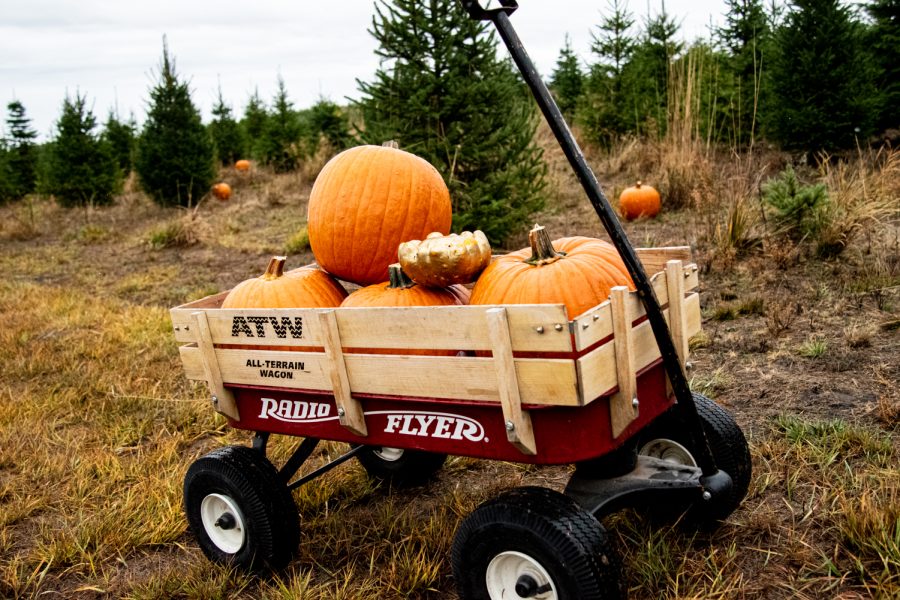Much ado about pumpkins
Pumpkins require a lot of sun, water, some fertilizer to grow in Palouse area
Pumpkins are scattered across the ground for a weekend pumpkin hunt hosted by the Spring Valley Family Tree Farm through October in Troy, Idaho. The farm began planting seeds later this year in mid-June because of early cold weather conditions.
October 27, 2021
Pumpkins, notorious for being carved and used in pie, are one of the first indicators of the fall season. But they are tricky to grow in the Palouse.
Pumpkins are fruits native to North America. Specifically, pumpkins are a distinct type of berry called pepo, which has a hard rind and multiple seeds, said Linda Cook, WSU professor for the School of Biological Sciences.
A pumpkin’s growing season is in the summer and lasts about 100 days. Pumpkins need a lot of sun, but this type of climate is not typical for the Palouse, so the harvest is not always successful, said Annette Brusven, one of the owners of Spring Valley Family Tree Farm in Troy, Idaho.
“Three years ago, [the pumpkins] were all green for Halloween,” Brusven said. “We didn’t have a long enough season and they never turned. So, it’s kind of iffy growing them up here on the Palouse.”
The planting process begins when farmers till the soil and plant the seeds. Pumpkins need a lot of water, so the farm has a drip irrigation system that runs on a timer, she said.
Once the pumpkins are ripe, they are harvested with pruners that separate the fruit from the vine. They are then stored until it is time to sell them, she said.
In order to successfully grow pumpkins, fertilizer is the key, she said. The farm’s first-ever harvest was unsuccessful because they did not use any.
This year, the farm saw its best harvest for pumpkins. Mid-May is the optimal time for planting in the Palouse area. But pumpkin seeds might rot and have to be replaced if it is still cold and rainy, so the farm did not start planting until mid-June this year, Brusven said.
The harvest can still be ruined by frost even once the pumpkins are grown, she said.
“Pumpkins are susceptible to frost. They can handle probably a very light frost, maybe 30 [or] 32 degrees,” Brusven said. “Anything lower than that can damage them.”
The farm mainly gets its income in December when they sell Christmas trees. The family decided to plant pumpkins as a way to financially support themselves during the fall season. Each pumpkin costs $5.
Cook said pumpkins are a great source of nutrition. Pumpkin flesh is mostly made of water, but there is some fiber as well. They are also full of vitamin A and beta carotene.
Pumpkin seeds are highly nutritious; they contain protein and important micronutrients. Pumpkin seeds might have been the reason why humans began domesticating pumpkins, she said.
“[Researchers] think that, initially, early hunter-gatherer societies were eating the seeds of these wild plants, and they began to artificially select for larger and larger seeds inside the plant,” Cook said. “They think that the fleshiness of the pumpkin fruit that we now see was actually sort of an accidental side effect of the artificial selection for larger, more numerous seeds.”
Aside from decorating and making pumpkin pie, Cook said Native Americans would cut pumpkins into strips and dry them to eat during the winter.
Brusven gives the leftover pumpkins to her friends’ goats and horses because they function as a natural dewormer. She said the animals like to eat them.
The farm grows a variety of different colored pumpkins, but orange ones are the most prolific for the harvest, Brusven said. But she noticed that the pumpkins were usually olive-green when she visited New Zealand.
“They still have orange flesh on the inside, but on the outside they are olive-green,” Brusven said. “So, pumpkins are not the same all over the world.”
There are different varieties of pumpkins, but they are all a part of the same species, she said.
The current record for the largest pumpkin weighs over 2,000 pounds. But they become less flavorful as they get bigger in size, Cook said.










